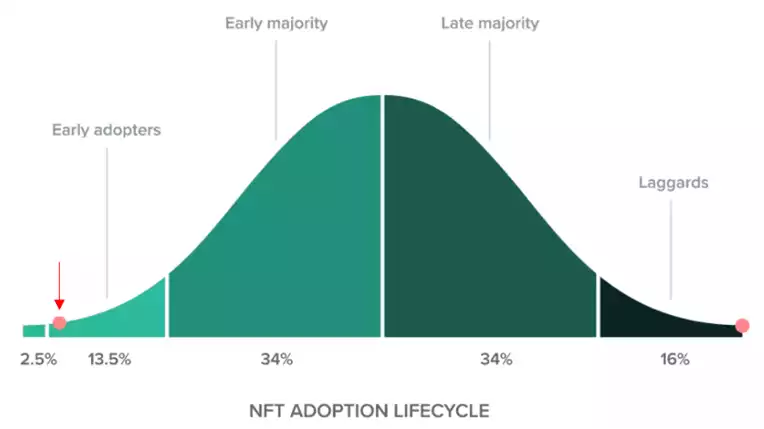NFTs Are a Big Deal!
News
|
Posted 13/04/2022
|
14986
Let’s start with ‘what are NFTs?’. NFT stands for non-fungible token. An NFT is a special type of cryptographic token which represents something unique. NFTs are deemed 'non-fungible' because they are not mutually interchangeable since they contain unique information. The most obvious benefit of NFTs is market efficiency and known scarcity. The conversion of a physical asset – like gold and silver – into a digital asset streamlines processes and removes intermediaries, saving costs.
But NFTs also represent something WAY bigger. NFTs are making waves in the world of finance and reserves. With accelerating digitisation, NFT innovations can have an even greater impact on how we store wealth for future generations to come - whether that means by transforming traditional drivers like network effects or trade linkages between countries' economies. Institutions that currently exist around banking systems have the potential to be replaced by NFT transactions.

Future innovations using NFTs, such as DeFi lending/borrowing, fractional ownership, crowdfunding, and more, have the potential to transform many, if not all industries. Without a doubt, it will democratise asset ownership. There will be many other developments in this decentralised economy that have yet to be imagined. What we can say is that it will be a much more transparent and direct type of market than what we are used to.
Every day we move further into a digital world. All modern society runs on databases. Our lives have been organised into thousands of databases that determine what we can do – what hotels we can check into, what Uber we can step into, where we're allowed to vote, how much money is in our bank account. All modern societies run on databases connected to the internet. Like all things centralised, this works OK. We call this iteration of the internet Web2. What NFTs are enabling is a new version of the internet, called Web3 (aka The Metaverse).
Global lockdowns caused by the Covid-19 pandemic have accelerated the transition to the Metaverse. Many individuals have adopted a more sedentary lifestyle and sought alternatives to maintain social connections due to prolonged periods of confinement and being deprived of interaction. As a result, people have engaged in various online Metaverse platforms to increase social engagement, which led to exposure to NFTs.
The Metaverse aspires to be co-created and built responsibly with integrity, safety, and privacy at the centre of its foundation. To support this framework, open standards and interoperability will be core to the Metaverse with new forms of governance likely to emerge.
Below is an illustrative scenario analysis around what percentage of the global digital market will shift towards the virtual world and apply a range of how the Metaverse may expand the total addressable market. In the most bearish case, roughly 15% of the digital economy will shift towards the virtual world. The potential Metaverse market is predicted to become a $6.91T-$$9.31T industry.

In 2021, users sent at least $44.2 billion worth of cryptocurrency to ERC-721 and ERC-1155 contracts, the two types of Ethereum smart contracts associated with NFT marketplaces and collections. Global non-fungible token market revenue growth is expected to be driven by the rising use of NFT in supply chain and logistics. The global non-fungible token market is expected to grow from $14.02 billion in 2021 to $21.33 billion in 2022 at a compound annual growth rate (CAGR) of 52.1%. The market is expected to reach $82.43 billion in 2026 at a CAGR of 40.2%. Increasing demand for a decentralised marketplace is boosting market revenue growth.
Without a doubt, Web3 and The Metaverse are where society is going. We believe that gold and silver have a home in this increasingly digitised future.
Currently, there are two methods by which to purchase precious metals. The first is to visit your local bullion dealer and make a physical purchase. The second is 'paper' gold and silver using various contracts such as CFDs. However, by utilising the blockchain, Gold and Silver Standard was able to introduce Gold and Silver Standard tokens (AUS and AGS). AUS and AGS are 100% backed by fully allocated, audited, and insured physical metal. Anyone, anywhere in the world could purchase this token and know that it holds intrinsic value and is pegged to the gold and silver price.
Typically, moving large amounts of wealth in stable assets (i.e., gold and silver) is a lengthy and expensive process that leaves you exposed to market risks and opens up security holes. AUS and AGS ensure that you are protected by the Ethereum blockchain when transferring or transacting.
The AUS and AGS tokens have come a long way since their inception as ERC-20 tokens. The natural evolution of the project was to create a series of gold and silver-backed NFTs. Much like how large bullion minters will produce limited runs of special coins, Gold and Silver Standard NFTs give the underlying precious metals artistic value even rarer than the metal itself – with enhanced visuals and a professional tone.
Throughout human existence, gold has represented wealth, opulence, status, prestige, and safety. Gold is so deeply ingrained in the way we think that it is second nature that we understand these things. These attributes can now immediately be applied to the Web3 world.
Tomorrow we will be sharing more details on an exciting project that we have been working on. We are bringing The Gold and Silver Standard to The Metaverse with NFTs.